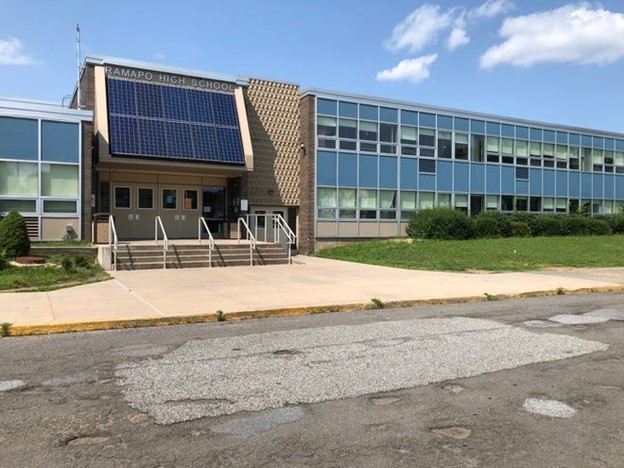Foil: Your right to Know.

Ramapo Senor High School
“Around 70% of East Ramapo buildings — including every single school — failed a recent safety survey, and others were determined to be unsatisfactory. Not a single building in use by the district was considered in satisfactory condition.
That’s according to a state-mandated Building Condition Survey that all school districts in New York must do every five years. Buildings are evaluated in about 50 categories, looking for structural and health and safety concerns. A single deficiency or critical failure can cause a building’s unsatisfactory or failing rating.
The survey estimated the costs for necessary repairs at over a quarter-billion dollars, but interest and other costs, one official said, could drive the total closer to a half-billion dollars.Many of the issues found were familiar problem spots in the district. That includes non-functioning drinking fountains in all schools; water access for drinking and cooking has been shut for years after tests showed unacceptable lead levels. Mold was cited at Spring Valley High School in the survey; the building temporarily closed in fall 2021 and students attended remotely after concerns that mold abatement could lead to asbestos exposure.
The survey also listed unsatisfactory kitchen hoods at five schools, which are undergoing replacement after the state stepped in; the kitchen hood project is expected to be completed at all schools in September. The kitchen work, and quality of food brought in while the schools don’t have functional kitchens, has been a topic at nearly every recent school board meeting. Students and parents have complained about cold and spoiled food being served; district leaders say they have focused on improving the food. At 11 out of 13 school buildings, ventilation was rated as unsatisfactory; 12 of 13 had unsatisfactory HVAC control systems.
The district has plans to address many of these issues with federal COVID aid, including about $90 million specifically earmarked for such work.
“Since the district received more than $150 million in federal American Rescue Plan Act (ARPA) funding in 2021, we have allocated more than half to our most pressing facilities needs,” East Ramapo schools Superintendent Clarence Ellis said in a statement. “We know children learn best when they are safe, healthy and comfortable. These critical building upgrades are improving the academic environment in our schools and have already made a profound impact on student learning and achievement.”While work is ongoing, the survey by CSARCH, an architecture, engineering and construction management firm, shows much more is needed.
Monitors:$44M deficit looms if voters keep tanking East Ramapo school budgets
Finding the hundreds of millions of dollars that likely will be needed to fix the issues outlined in the Building Condition Survey would be a tall order for a district that’s seen a string of budget defeats at the polls. The district was able to pass a 2023-24 spending plan only on a revote for a budget that will hold the tax levy flat and result in reduced property taxes.
‘That’s the shame of this community’
Mary Fox-Alter, in her last meeting June 20 as a state-appointed education monitor, made clear that East Ramapo was an outlier in its poor performance.
“There are severe and serious issues with the facilities here in this school district. There has been continuous deferred maintenance,” said Fox-Alter, who left her state-appointed position this month to take over as interim superintendent for Ossining schools.
She said similar issues were mentioned in the 2014 state report, “East Ramapo: A School District in Crisis,” that called for state monitorship over the district.
The CSARCH report put the price-tag for repairs at $236,267,632.
The state’s fiscal monitor, Bruce Singer, at a June 20 board meeting, said after interest and other costs are considered, the needed repairs would likely total closer to $500 million.
Fox-Alter said state building aid could help pay for 50% of such repairs, “but they’re not going to cover the whole thing.”
Fox called facilities problems “a crisis that needs to be addressed.”
And Singer made clear that the lack of investment in schools can be linked to repeated rejection of budget plans that raise property taxes. “That’s the shame of this community,” Singer said. “We’re putting our children in jeopardy. That’s not right.”
Building conditions among larger concerns
The district educates 10,500 public school children. Many are recent immigrants who are learning English and often facing education loss and trauma. Early into the 2022-2023 academic year, the district reported more than 1,000 new students had shown up, almost all new immigrants in need of language and other services. Another 35,000 children live within the district but attend private schools, mostly yeshivas that serve a growing Orthodox and Hasidic Jewish population. East Ramapo provides mandated services, such as transportation, for all children within its boundaries. With hundreds of private schools serving local children and the district’s “universal busing” regulations that provides a ride for any child no matter how close their school may be to their home, East Ramapo has the most extensive school busing system in the state outside New York City.
The district is governed by a nine-member school board that is elected through a ward system. Six members are white men who are generally seen by the public-school community as favoring the yeshiva system. Three Black women with direct ties to the public schools fill the other seats.
East Ramapo has had more voter-defeated budgets than any other district in New York in recent memory. This past academic year, the district operated under a contingency spending plan after two budget defeats at the polls.
Meanwhile, extra federal COVID funds are running out, a situation monitors have said will create a “fiscal cliff.” A $40 million deficit is predicted by 2026, according to a report by Singer and Fox-Alter, and that’s even if voters pass modest budget increases. If budgets fail or tax hikes are held flat, the deficit could hit $44 million.
Call for state to act
The report on building conditions added to the concerns of community advocates.
New York Civil Liberties Union, which successfully mounted a voting rights challenge against the district, called on the state to take control of the situation.
“The district has clearly demonstrated that it cannot provide a safe environment for children,” said Johanna Miller, director of NYCLU’s Education Policy Center. “The state must take over and establish an immediate plan for improving conditions.”
Miller called conditions deplorable. “It is unconscionable that New York leaders are sitting idly as students in East Ramapo encounter contaminated water and broken down facilities every day at school.”
A 2010 study published in the American Journal of Public Health looked at Building Condition Survey reports for districts across upstate New York and found that the presence of mold, moisture, ventilation problems and other system problems were associated with school absenteeism.”
Read the complete Journal News coverage here.





